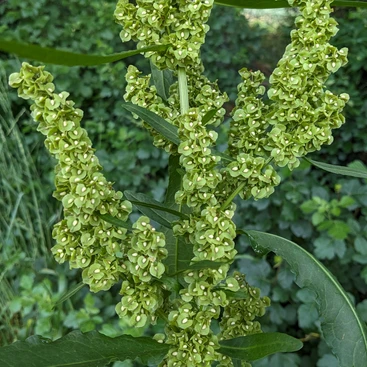How to Forage Curly Dock, Edibility & Foraging Curly Dock 🌱
We’ve been covering a lot of weedy plants with my recent articles on and for good reason. They’re widespread, common in most yards and gardens, easy to learn, and great for beginning foragers. This plant is no different! Let’s learn about identifying and foraging curly dock.

Description
Curly dock is a widespread perennial that grows as a rosette from a large, bright yellow, forking taproot. The leaves start off as a tightly rolled tube and unroll from the middle out, like a scroll, as they mature. They can reach lengths up to two feet! The leaves are smooth, slightly succulent, and have wavy or curly edges, from which the name curly dock comes. The leaf bases are wrapped in a papery sheath filled with clear slime.


The flower stalks have some sparse leaves and, eventually, clusters of green flowers and fruits. The flowers are three-sided and encase a small fruit. These eventually transition from green to yellow to reddish and then dry to a rusty brown. The brown stalks can often remain on the plant through winter, which makes them easy to recognize.


Range & Habitats
Curly dock is native to the temperate climates of Europe and Asia but is found across much of the world. It has been documented throughout North America, Europe, and parts of South America, Asia, Africa, and Australia. It is considered an invasive species in some regions because of its tendency to spread and establish quickly. This plant tends to grow most successfully in areas of human disturbance. It can often be seen in large numbers across recent construction sites, abandoned lots, and other urban developments. It’s also a frequent weed in yards and gardens. In my area, I often see it growing in abandoned lots, construction sites, along roads, and other heavily trafficked areas (not a good place to forage them). We have a few plants that I harvest from around our house, but I don’t allow them to go to seed to prevent them from spreading.
Potential Look-alikes
The information in the description above should be enough to identify curly dock properly. However, look-alike information is something that is regularly requested, so here are some possible species that could be confused with curly dock. This list is not comprehensive and may not be relevant to your region. Remember only to eat wild foods once you’re 100% confident in your identification and comfortable with trying something new.
-
Other Rumex species. Many are edible, though some are not good to eat.
-
Before flowering, houndstongue, Cynoglossum officinale, can be similar but has fuzzy leaves. It is toxic.
-
Common burdock, Arctium minus, could be confused with curly dock when very young. The leaves and other parts are edible but must be processed to remove their bitter coating.

Edibility & Foraging Curly Dock
The leaves are best when young and tender. As they mature, they can become tough and bitter-tasting. To harvest, look for leaves that are still partially rolled or just unrolled. Look for vertical creases running up the leaves and test them to see if they stretch without tearing (a trick taught to me by Sam Thayer). Those tender leaves can be cut or pinched off at the base. The sheath and slime around the leaves are harmless and easily washed away. Some older dock plants can produce large leaves very quickly. These leaves can also be used if they are still tender and taste good. They are especially useful for stuffing and rolling!

The young shoots should be harvested well before flowering. They have a tart flavor and a nice crunch, making them a decent substitution for rhubarb. To harvest, simply cut or break the stem away where it’s tender.

Finally, the seeds and attached flowers can be dried and ground into flour. These should be collected in late summer and fall once they have turned rusty brown and dried on the stalk. The easiest method for harvesting lots of dock seeds is to place the dried flower stalk in a paper or cloth sack and then run your closed hand down it, pulling off all the seeds into the bag as you go. Some people find the seeds and flowers bitter, so give them a taste and try mixing them with standard wheat flour to balance out the flavors.

Foraging Calendar
To learn more about the best seasons to harvest curly dock and many other wild foods, check out my You can try the to learn more, and gain full access to the Foraging Calendar and other exclusive perks! Joining is the best way to support all the work I put into my content and website to help you learn about foraging! Thank you for checking it out!
